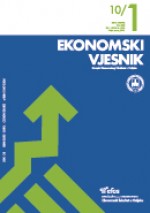Model odnosa cijena i zarada kroz dividendni prinos i zahtijevani prinos iznad očekivane inflacije
Price/Earnings Ratio Model through Dividend Yield and Required Yield Above Expected Inflation
Author(s): Emil MihalinaSubject(s): Economy, Business Economy / Management, Financial Markets, Accounting - Business Administration
Published by: Sveučilište Josipa Jurja Strossmayera u Osijeku, Ekonomski fakultet u Osijeku
Keywords: price and seven-year average earnings ratio; expected inflation; stable inflation; dividend yield; profit growth; modelled price/earnings ratio;
Summary/Abstract: Price/earnings ratio is the most popular and most widespread evaluation model used to assess relative capital asset value on financial markets. In functional terms, company earnings in the very long term can be described with high significance. Empirically, it is visible from long-term statistics that the demanded (required)yield on capital markets has certain regularity. Thus, investors first require a yield above the stable inflation rate and then a dividend yield and a capital increase caused by the growth of earnings that influence the price, with the assumption that the P/E ratio is stable. By combining the Gordon model for current dividend value, the model of market capitalization of earnings (price/earnings ratio) and bearing in mind the influence of the general price levels on company earnings, it is possible to adjust the price/earnings ratio by deriving a function of the required yield on capital markets measured by a market index through dividend yield and inflation rate above the stable inflation rate increased by profit growth. The S&P 500 index for example, has in the last 100 years grown by exactly the inflation rate above the stable inflation rate increased by profit growth. The comparison of two series of price/earnings ratios, a modelled one and an average 7-year ratio, shows a notable correlation in the movement of two series of variables, with a three year deviation. Therefore, it could be hypothesized that three years of the expected inflation level, dividend yield and profit growth rate of the market index are discounted in the current market prices. The conclusion is that, at the present time, the relationship between the adjusted average price/earnings ratio and its effect on the market index on one hand and the modelled price/earnings ratio on the other can clearly show the expected dynamics and course in the following period.
- Issue Year: 23/2010
- Issue No: 1
- Page Range: 114-124
- Page Count: 12
- Language: Croatian

